Free shipping for all orders over 35 euro!
-
Shop
- Insights
-
About ROMBO
- Dealers
- Guitar Pick finder
- Gift Card
+Categories
- accessories
- bass
- bass pick
- bass picks
- bass plectrum
- bass plectrums
- beginner
- bright tone
- chose guitar pick
- chose guitar picks
- chose plectrum
- chose plectrums
- CrystalBright
- Diamond
- Diamond pick
- discipline and guitar
- DIY generation
- durability pick
- durable pick
- eco
- ecoblack
- find guitar pick
- find plectrum
- fingers vs picks
- grip
- grip guitar pick
- guitar accessories
- guitar advantages
- guitar benefits
- guitar career
- guitar health
- guitar injury
- guitar learn
- guitar lesions
- guitar lesson
- guitar method
- guitar noise
- Guitar noise plectrum
- guitar pain
- guitar pick
- guitar pick beginner
- guitar pick bevel
- guitar pick buy
- Guitar pick diamond
- guitar pick durability
- guitar pick durable
- guitar pick eco
- guitar pick features
- guitar pick grip
- guitar pick material
- Guitar Pick Noise
- Guitar Pick online
- guitar pick recycled
- guitar pick recycled material
- guitar pick special features
- guitar pick textures
- guitar pick thickness
- guitar pick variable thickness
- guitar picks
- guitar tone
- guitar warm-up
- guitarpick
- guitarpicks
- hold a guitar pick
- hold guitar pick
- hold guitar picks
- hold pick
- hold plectrum
- hold plectrums
- how to
- how to chose your guitar picks
- jazziii
- learn guitar
- lose guitar pick
- material
- materials
- mental health and guitar
- motivation and guitar
- music
- not to lose guitar pick
- Online guitar
- online guitar pick
- online guitar pick buy
- pick
- pick durability
- pick material
- pick noise
- Picks
- picks vs. fingers
- play bass fingers
- play bass picks
- play bass with fingers
- play bass with pick
- play bass with picks
- play bass with plectrum
- play guitar faster
- plectrum
- plectrum attributes
- plectrum beginner
- plectrum bevel
- plectrum characteristics
- plectrum features
- plectrum grip
- plectrum material
- plectrum noise
- plectrum recycled
- plectrum shape
- plectrum variable thickness
- plectrums
- Plek
- pua
- recycled
- recycled guita pick material
- recycled guitar picks
- recycled picks
- recycled plectrum
- Rombo Diamond
- rombopicks
- tendonitis guitar
- the guitar pick
- tone
- variable thickness
- warm tone
- warm-up guitar

Why a guitar pick variety pack is a great choice for beginner and advanced guitar players
1- What is a Guitar Pick Variety Pack
A Guitar Pick Variety Pack is a set of at least three different guitar picks aimed to contain different shapes, sizes, materials, or thicknesses of plectrums.
There are other common names for this type of guitar pick set, like “Try out Mix,” “Guitar Pick Mix Set,” or “Guitar Pick Box.” Some variety packs are focused on specific guitar areas like a “Heavy Gauge Variety Pack,” thought to be used by advanced players or “Beginner’s Variety Pack” containing medium and thin guitar picks.

On guitar picks, qualities like thickness, shape, size, and material play a pivotal role in the guitar tone, sustain, grip, or pick noise.
Therefore, it is not only about the personal preferences of the player but also about the techniques you want to develop. Your hands do an arduous job, give them the proper tools they need.
2- Reasons why a Variety Pack is a good idea
REASON ONE - It is the fastest and cheapest way of changing your guitar tone
Think about it: The guitar, strings, amp, cable, and effects pedals are all pieces of the guitar gear that play a role in tone. Surprise: guitar picks too!
Use a rounded thick nylon pick and you’ll get mellower, darker, and thicker tones. Use a pointy medium Tortex guitar pick and your tone will be as bright as you can imagine.
It only takes two seconds and the cost of a coffee to change your pick and increase your tone spectrum. Larger tone repertoire means larger versatility.
Music is about staying dynamic, and monotony kills dynamics. Therefore, your most logical step as a guitarist is to find ways of expanding your repertoire of tones and techniques. This happens with practice and the right guitar gear.

REASON TWO - The joy of exploration
Music theory, speed exercises, precision exercises, and warm-ups all have one thing in common: They focus on improvement, repetition, and perfection.
However, performance is not everything and sometimes we should focus on the joy of exploration.
The greatest ideas happen when we achieve a “flow” state, also known as the “zone.” This applies to guitar too! So, why not relax for a day, test some new pieces of gear, spark some creativity by playing around some guitar phrases, and then see what happens without planning too much and having the pressure of achieving one specific performance milestone?
Chose 4-5 different picks, turn on the amp, and give yourself a two hours break by enjoying the music you are playing now.
PS: Don’t forget to turn off your phone!
REASON THREE - Develop specific skills
Try to perform your speed exercise with a large, worn-out, thin guitar pick. Let’s say 0.35 mm.
You will face one of these three scenarios:
- You are slower than usual.
- You are as fast as usual but your technique is bad.
- You are slower and your technique is bad.
As in every discipline, using the right tools is the key to success.
“Modern Guitars” are attributed to Spanish musician, Antonio de Torres Jurado. He was a luthier, and in the mid-1800s, he began creating the style of guitar that would rise to all modern guitars.

Imagine then how immense the number of available guitar techniques that had more than a dozen decades to be developed is. From strumming to hybrid picking, palm mute, sweep picking, or down picking, all these techniques have different requirements, and different requirements can be fulfilled with different tools.
In our article, “7 essential guitar pick techniques,” we have summarized some of the most common techniques.
REASON FOUR - Different instruments
Sure, the average guitar player owns a red Stratocaster with 09 strings and plays classic rock.
But what about the rest of us? The 7 strings shredders, the acoustic unplugged fans, the indie effect experts, the experimental music lovers, the metal-heads, the bassists using picks, and the jazz/bossa relaxed musicians out there?
We all deserve to have a choice according to our requirements.

Personally, I like to play bass with a medium pick (Rombo Prisma), and I love the warm tones of Rombo Horizon for guitar reverb phrases on my telecaster. However, when I feel like using the thickest metal distortion ever, I choose Rombo Diamond.
Different guitar pick shapes, sizes, materials, and thicknesses create a widely broad tonality and usability ranges that I need to keep my motivation up!
REASON FIVE - A fresh input kills routine!
Did you use the same guitar pick for the last 20 years? Well, it’s never too late to get a little bit of fresh air and try something new.
Even the riff you have played 1000 times will sound different and you might notice that there are some nuances on “pick feedback” that can make your sound more fun and interesting.
What is the worst that can happen? In the worst case, you will discover a guitar pick that you prefer more than your usual! Go take that risk :-)
REASON SIX - A Guitar Pick Variety Pack is a great gift
Guitar players have a lot of things going on in their heads: the next gig, one unfinished song composition they started some weeks ago, the speed rates of their last practice, and more.

A Guitar Pick Variety Pack is a great gift for beginners, intermediate, or advanced players. Guitarists love trying new gear because it is a way to spark some creativity and explore tonalities.
A variety pack is a super affordable option for a small, but elegant gift to make a guitarist smile and feel excited for the next practice day.
There are many different gift options from Rombo:

If only one of the guitar picks is chosen as the new favorite one, your friend will be thankful for life!
REASON SEVEN - Reflecting on your guitar tone and level
Even if you don’t like the picks included in the variety pack, they will have a positive effect on your playing.
You will reflect and confirm why you had chosen your current pick in the past and what the advantages of it are. You will reflect on your guitar tone and the nuances of guitar pick feedback and pick noise.
These experiences accumulate, and after years of exploration, you start having a sixth sense of “feeling” your instrument, your preferences, and music in general.
What do you do with your new picks? Well, if you don’t like them, give them to a friend that could need inspiration!
3- Who can profit from Guitar Pick Variety Packs (Spoiler: Everyone)
From the reasons above, we can take away a clear lesson: It doesn’t matter if you are a beginner or an advanced player, the advantages of trying a Guitar Pick Variety Pack are always there.
Why beginners profit from Guitar Pick Variety Packs:
- Develop new skills.
- Develop a sense of exploration and identify tone nuances.
- Understand that different techniques need different requirements.
- Understand that the guitar path is a long one and that not everything is performance.
Why intermediate and advanced players profit from guitar pick variety packs:
- Expand the spectrum of techniques.
- Discover an unexpected tonality change.
- Focus on one specific technique.
- Joy of exploration.
4- Examples of a guitar pick variety pack
One example is our own guitar pick variety pack containing:
- 1 Rombo Classic | 0.45 mm
- 1 Rombo Origami | 0.75 mm
- 1 Rombo Prisma | 0.8 mm
- 1 Rombo Crisp | 1 mm
- 1 Rombo Waves | 1.25 mm
- 1 Rombo Horizon | 1.4 mm
- 1 Rombo Diamond | 2 mm
- 1 Rombo Jade | 2.3 mm
It is not only thickness that is everything. In order to make these picks more understandable for you, we have created four metrics: Attack, Flexibility, Tone, and Techniques. Here an example:

With this information, and in combination with the description of the pick and the technical drawing, we give you a very precise picture of the qualities of our guitar picks.
We also have a specific set for beginners with the “Beginners Guitar Pick Gift Box”:
And a specific set for intermediate/advanced players.

5- Conclusion
A Variety Pack is not only an excellent gift for your musician friends, but also for yourself if you are looking to explore tones, develop specific skills, or just need fresh air and try new guitar gear.
Different qualities like shape, thickness, or material, make guitar picks very different tools for different requirements. You will learn a lot in the process of testing them and every fresh input can help keep your motivation at the highest level.
The worst case: You will discover your new favorite pick!
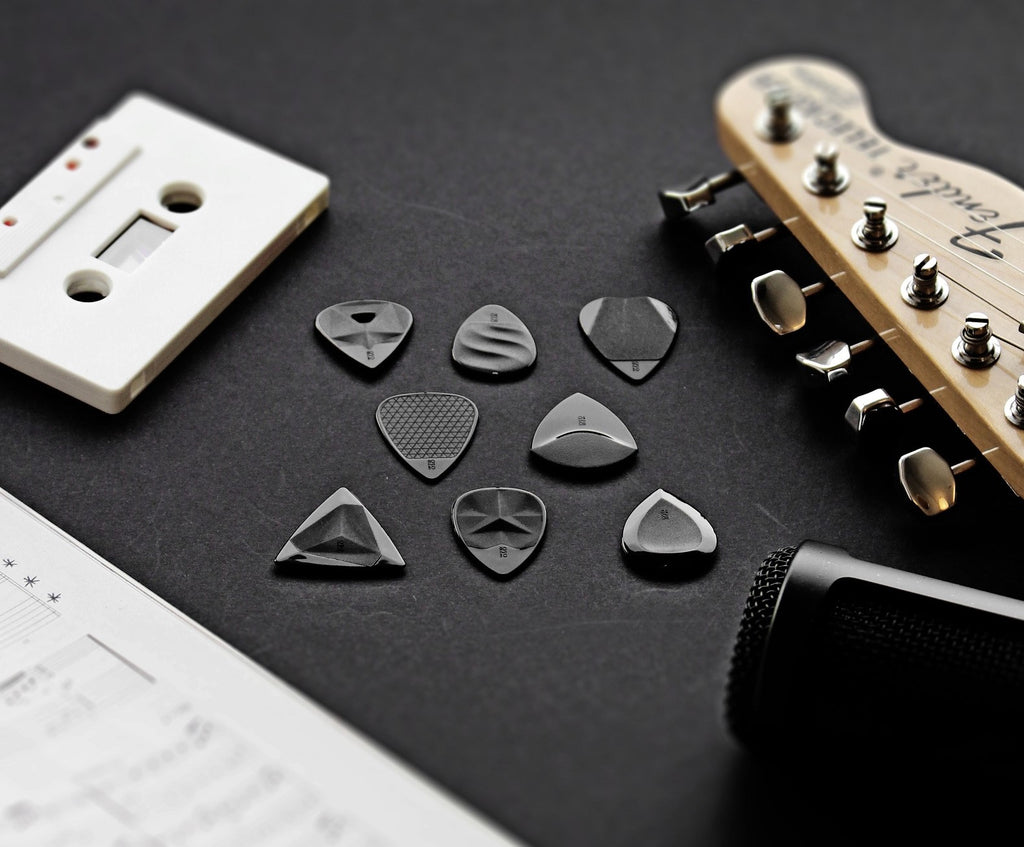

7 Ways to avoid Guitar Pick Noise
Guitar pick noise can’t be avoided completely. Especially while recording acoustic guitar, plectrums tend to create a lot of click and clack sounds and noises that can ruin your playing experience as well as your listeners’.
As you learn how to play the guitar better, you will reach a point where you want to focus on transmitting emotion, playing with impact, and enhanced dynamic control.
In order to master your guitar techniques, you must have total control of every sound produced by your guitar; intended and unintended.

Personally, I think pick noise is a part of the guitar playing, and I even enjoy some vintage recordings where the guitar pick noise seems to be present almost on purpose. However, for most of the occasions, you want to eliminate it.
We have summarized all the tips and tricks we think can help you reduce the noise when playing with a guitar pick. Enjoy it!
1- Hold your guitar pick with less tension
Guitar picks create noise when plucking your strings. Holding your guitar pick more loosely will help a lot, since your fingers absorb some of the energy when the pick hits the strings.
We have published an article called “How to hold a guitar pick”, which contains everything you need to know to master this trick.

If you are recording your tracks, one thing that can help is to add some more volume to your instrument in relation to the others. This is a common method used in studios that helps the guitar players to relax.
Whether you are planning a studio session, a jam with your friends, or some solo relax sessions at home, a conscious warm-up before playing guitar is mandatory.

2- Try different angles when plucking your string
The angle of the guitar pick in relation to the strings is the most discussed element when it comes to guitar pick noise.
Basically, the less pick is in contact with your guitar strings, the less noise it produces. Angle the pick slightly to the strings.
Try different angles when plucking your string. This will require a conscious adjustment from your side, but once mastered will allow you to vary the attack of the pick more easily.
Depending on the guitar pick you are using, the music style and guitar techniques you use, and your skill level, you will need a different attack angle, so focus 30 minutes on trying to find the best one for you and get used to playing this way.
3- Is your picking force adequate?
Sometimes you are playing and the flow starts, you mentally leave the room and enter “the zone”, that beautiful place where you sound better than usual.
We get so much into the music, that we just naturally pick harder.

Excessive picking force is one of the most common causes of guitar pick noise. In addition, it can choke out the sustain and cause the notes you are playing to decay in a much less natural way.
4- Nylon guitar picks are less noisy
The material of the guitar picks not only affects the tone, but also the noise the plectrum creates.
Nylon is considered to be one of the least noisy formulas when it comes to industrial materials used for guitar picks.
This is due to the toughness of this compound, which thanks to its mechanical properties, is able to absorb heavy impacts efficiently.

At Rombo, we are using a modified version of nylon, which adds some extra durability and prolongs the lifespan of the guitar picks. This was necessary since nylon guitar picks wear down very quickly. You can learn more about the materials here.
If you are not sure if you are using the right guitar pick, a good option is a variety pack, which contains guitar picks with different attributes. This is a good way to test several picks and track your development as you start increasing your skill for each one.
The right guitar pick thickness
As a rule of thumb, you can estimate that heavier picks will be less noisy, which sounds kind of contradictory. But, why is that?

Using very thin picks in combination with fast-playing, like strumming, will cause the picks to bend as they leave the guitar strings, creating a kind of click noise. This happens especially when playing acoustic guitar, since the body of the guitar will act as an amplifier for that sound.
Heavier picks will let each string make its own noise without much unwanted accompaniment.

The variable thickness, included in all our guitar picks, not only improves the control but also reduces the noise. The body of the plectrum is thicker and stiff, while the tip is thinner and more flexible. With this feature, the overall flexibility of the tip is reduced while conserving its original thickness and material. This means more control and less noise.
Thick vs. thin guitar picks. In this article, we discuss all the aspects that make a difference.
A beveled edge can help you reducing the pick noise
Guitar picks with a beveled edge will slide better and cause less noise. In combination with the angle of attack we already mentioned, they can help you reduce the pick noise a lot.
Also, the shape and size of the pick are important, but this is more a matter of preference.

Reduce pick noise with a polished tip guitar pick
We have frequently discussed the impact a polished tip has on the tone and durability of a guitar pick.
A polished tip also slides quite easily over the edge of the guitar string. On the other hand, guitar picks with a rougher texture on the tip, will produce more treble response even when played on the edge. This also happens when the picks start to wear down.

However, as mentioned at the beginning of the article, some purist guitarists even prefer the pick to create noises and they included it extra in their recordings.
Bonus: Record yourself
Very experienced live players that don’t have much studio experience sometimes do not reflect enough on all the little nuances on their playing.

A good exercise to avoid this is to record yourself. It is amazing how much we miss when we get into the zone. You will notice pick noise when listening to your tracks and it is much easier to identify critical areas than while you are playing.
If you play acoustic guitar, try to locate the microphone(s) in different locations, you will discover how much of a difference it can make in terms of guitar pick noise.
Conclusion
We can’t eliminate pick noise completely, but there is enough to do to improve our playing and reduce it substantially.
The best way to reduce pick noise is to be aware of it and reflect on your playing to improve your skills and try different picks for different styles and guitar types.
If you discover a new way to reduce the pick noise, please let us know so we can include it in the article!

Guitar Pick for Beginners
Guitar picks are one of the most useful accessories for beginners, who have just started to play the guitar or bass.
Having a guitar pick won’t make you a professional guitar player faster, but will enhance the playability of your guitar.
With the right plectrums, you can easily learn new techniques and shape your skills.

The amount of guitar pick brands available on the market today is huge. This can be overwhelming if you are a beginner guitarist, and choosing the right guitar pick can be a tough process if you start in the wrong place.
But first of all: Who is considered a beginner guitar player?
Who is Considered A Beginner Guitar Player?
A beginner guitar player could be someone who just started playing last week, or, someone who has been practicing guitar for 2 months.
It is very difficult to define a line between the beginner and intermediate stages of guitar playing. Especially when you have learned to play the guitar yourself.

In general, to be considered an intermediate player, you should know and master the following areas:
- Change smoothly between fundamental open chords.
- Know power chords and be able to move around then cleanly.
- Know the difference between major and minor basic chord shapes and sounds by hearing.
- Know the note positions on the fretboard for the low E and A strings.
- Having mastered a significant amount of strumming patterns.
- You are able to practice using a metronome, and are aware of your comfort tempo for every technique.
- Have a basic understanding of music theory for musical keys and chords.
- Play through several complete songs smoothly.
- You’ll need to feel familiar with the basic lead techniques of picking, bending, and sliding,...
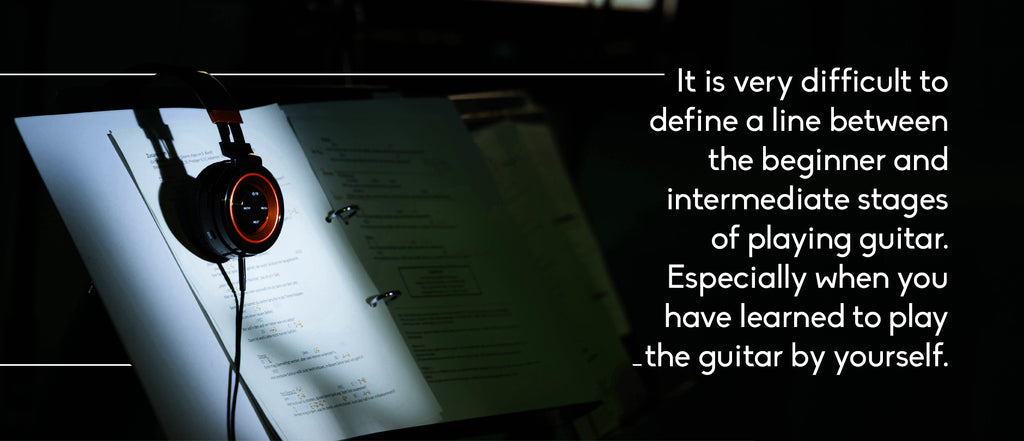
Why Use Guitar Picks?
Guitar Picks have different advantages when comparing them with fingers.
Guitar picks help increase your playing speed, produce a louder, brighter sound than fingers, and can be shaped to achieve better results when using different techniques like strumming or palm mute.
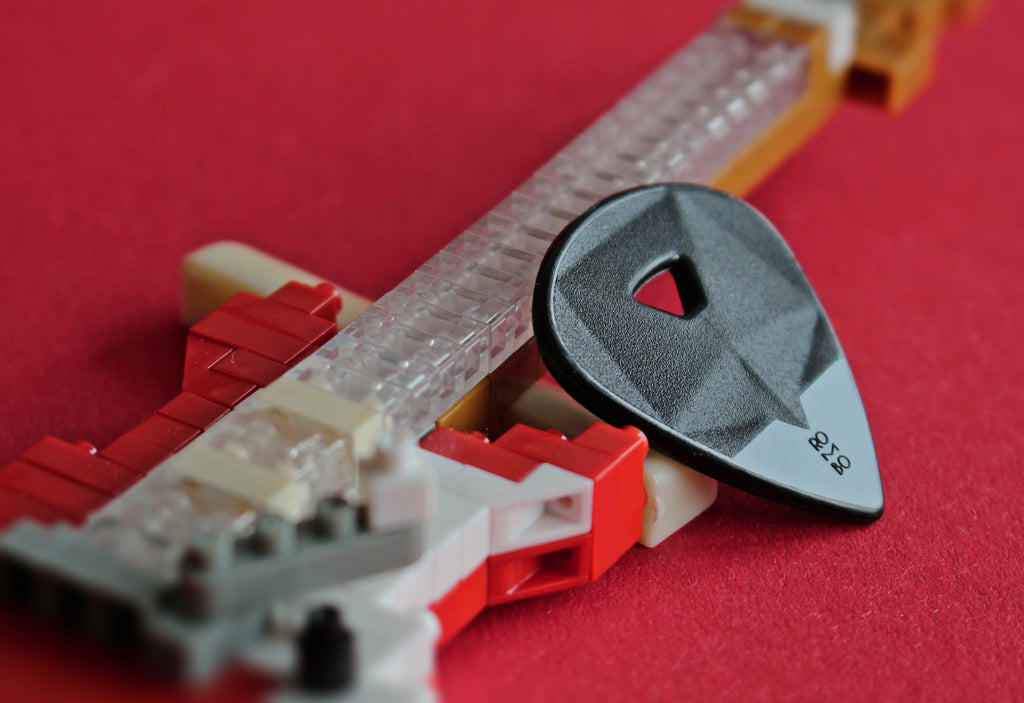
In general, plectrum techniques are easier to master than classical fingerstyle, or hybrid. It is easier to play fast picked notes.
As a beginner, this is very motivating, since your process of learning will be accelerated.
Guitar Picks - Quick Guide:
At the very beginning of your guitar learning process, your feeling of sound and feedback provided by a guitar pick as not yet developed.
Therefore, you should consider only these two attributes of a guitar pick:
- Guitar Pick Thickness
- Guitar Pick Shape.
Simplifying the “science” of a guitar pick will help you make a fast choice without spending too much time and stress.
After your first couple of months playing guitar, you will develop new skills, which will allow you to introduce more complex factors to your final decision of which pick to buy, guitar pick material, guitar pick size, and other special features.
If you feel secure enough to understand these additional features of a plectrum, go to our guide: How to choose the right guitar pick, which you can find HERE.
For the thickness and the shape, here is where you should begin:
0,75 mm Guitar Picks: The Best Choice for Beginner Guitar Players
Light guitar picks with less than 0,6 mm are considered beginners’ guitar picks.
The reason for this, is that most beginner guitar players first learn strumming techniques, which can usually be played better with thinner plectrums.
However, medium guitar picks with 0,75 mm thickness are the best place to start.

Plectrums with medium thickness are the most versatile in terms of tone, and can be used for rhythm and lead guitar.
If you are having fun with strumming exercises, medium thickness will perform well. If you need to practice some lead guitar techniques, it will work as well.
Depending on the kind of guitarist you want to become, you may consider moving to a higher or lower thickness range afterward.
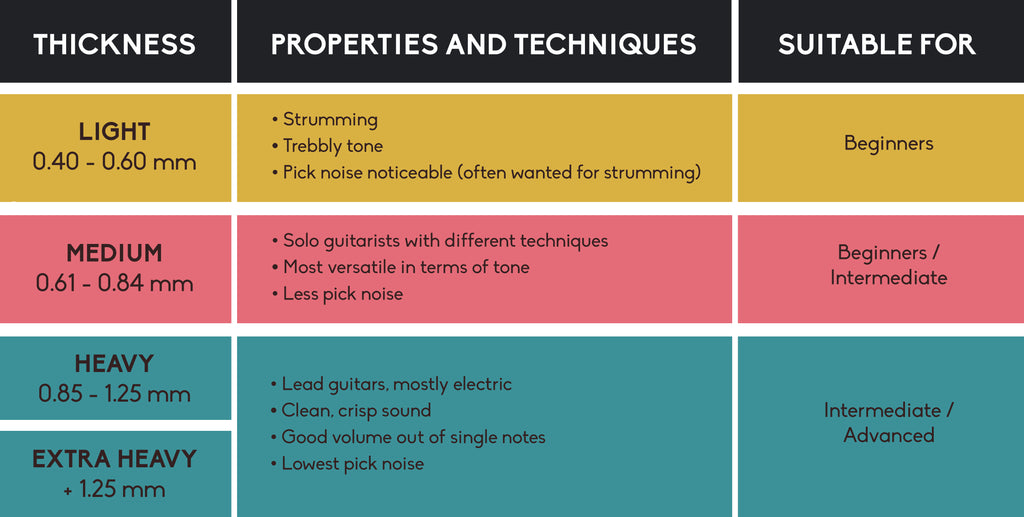
Rombo Origami is a good example of a medium thickness guitar pick.

Teardrop Shape and Standard Shape Guitar Picks: The Best Choice for Beginner Guitar Players
Teardrop shape and standard shape guitar picks are simply the most common shapes for plectrums, and globally famous by every single guitar player.
You cannot go wrong if you use one of these shapes for your first guitar pick.
Both picks have enough surface for a solid grip, and the tip has mostly a medium radius, and often even a light bevel edge for smoother playing.
When is it time to change the guitar pick?
I am not talking about wear and tear. For this, we already published the article “Guitar Pick Durability”
What I really mean is, when is it time to question the guitar pick model you are using and use a different thickness or a different material?
Avoid sticking with a single guitar pick model for the rest of your life.
Using different guitar picks will give you the possibility to increase your tonality ranges, develop a more accurate feeling for different guitar techniques, and be more aware of your preferences when it comes to guitar gear.
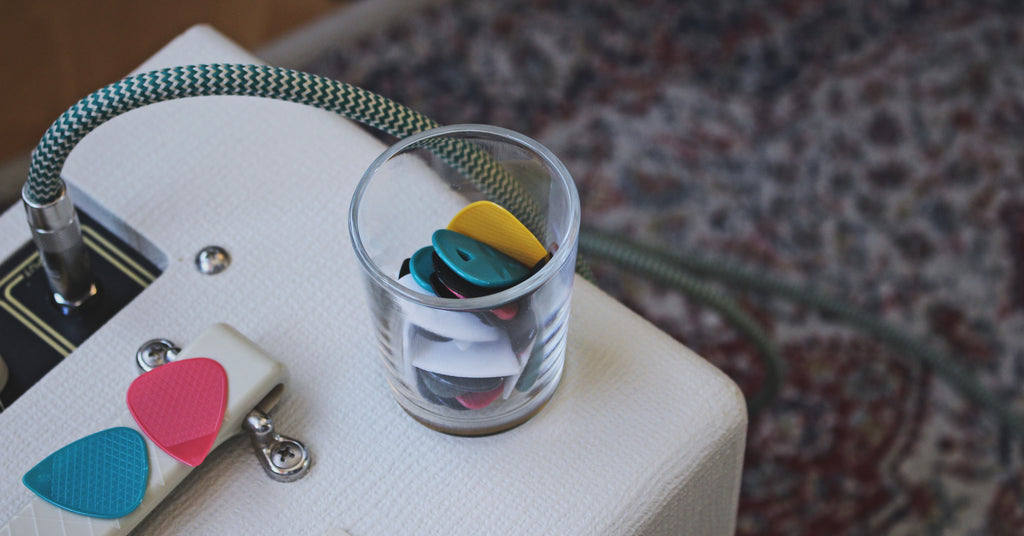
Therefore, the answer is: always! I cannot recommend enough, the benefit of testing as many different plectrums as possible, and then decide which ones are your favorites.
I used the plural noun “favorites”, because you should find at least 3 of your top guitar picks.

As you develop your skills as a guitarist, you will notice that some guitar pick shapes, or guitar pick thicknesses, are more adequate for specific techniques.
Discover our variety pack HERE
In my case, I like medium picks for strumming, hard ponty guitar picks for practicing scales and loud music, and very rounded guitar picks for the days I just want to relax, use my reverb pedal, and create beautiful clean guitar melodies.
Conclusion: The Right Guitar Pick For Beginners
An important part of learning guitar, is knowing the gear you use: The amplifiers, the pickups, the different guitar strings, the guitar pedals, and also the guitar picks.
Don’t feel overwhelmed by the amount of guitar picks out there. It’s just a matter of preference, and you will have to spend some time trying new guitar picks, which can be fun and bring you some nice experiences.
You can start with a standard shaped guitar pick with 0,75 mm thickness. But, if you don’t feel comfortable with just one option, try a variety pack, containing some different guitar picks. Close your eyes, and chose the guitar pick that feels right to you.
Please leave a comment and tell us the thickness of the first guitar pick you had. Thanks!

Guitar Pick Durability: Everything You Need To Know
The guitar pick has been in constant evolution since the 1920s.
Today, 100 years later, we have achieved great accomplishments in the area of durability of this very important piece of guitar gear.
In this article, we will review all the important points that can cause picks to wear out, and summarize all you need to know about guitar pick durability.
We will make some comments on the tone, to help control the changes, which happen after a guitar pick has worn down.
In addition, we will give some advice to keep your picks “healthier“, longer than expected.
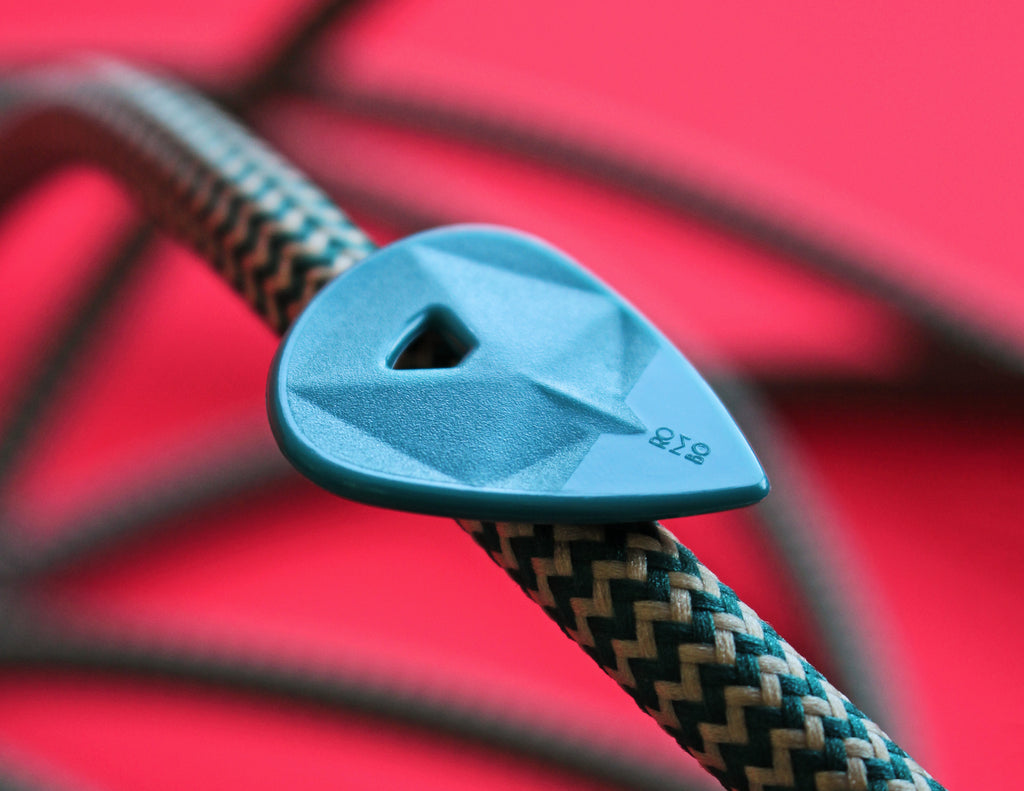
New vs. Old (worn down) Guitar Picks: Tone Changes
We all know that using different guitar picks, will also make a difference in your tone, and your playing. Material, shape, thickness and shape of the pick, directly affect the tone and playability.
Most standard plectrums can resist heavy strumming for a long time, without much wear and tear.
The first thing you may notice after using a guitar pick for some weeks, is that the tip is not as pointy as the new guitar pick. You will see it, and you will hear it, because the tone of the pick will change over time, with wear.


The rounded shape of the worn down plectrum, will create warmer tones, and feel darker. This is totally fine, if this is the tone you are looking for.
It will also affect the way your plectrum plucks the strings:

Just like the guitar strings, the frets, & other components, the guitar picks will wear out over time.
Some players feel a lack of control after the guitar pick has worn down, while others use the rounder picks because of the tone they produce. This especially happens to jazz guitarists, who tend to choose picks that are almost circular, for example: Rombo Waves.
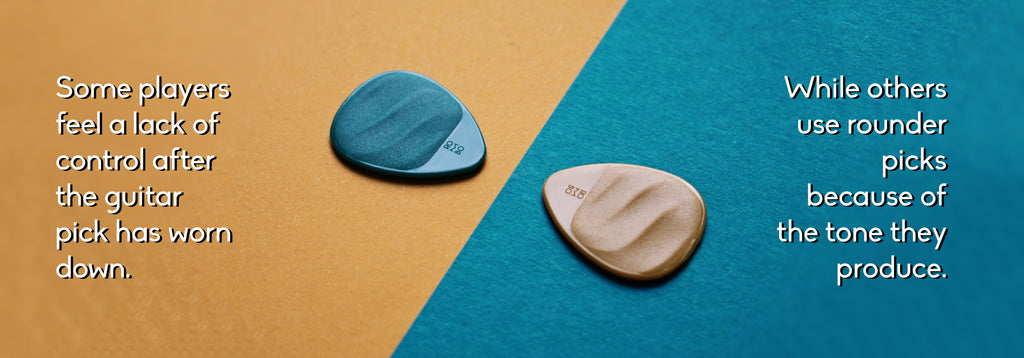
Gaining control when using rounder guitar picks, is an ability you can train yourself to do, and improve.
Why Can’t Picks Last Forever?
Guitar strings are usually made from a mix of steel, nickel, bronze, or brass. In other words: Metals.
Since most players use some kind of plastic material for their guitar picks, (nylon, delrin, …), it’s not surprising that friction between strings and picks will cause the guitar picks to wear down.
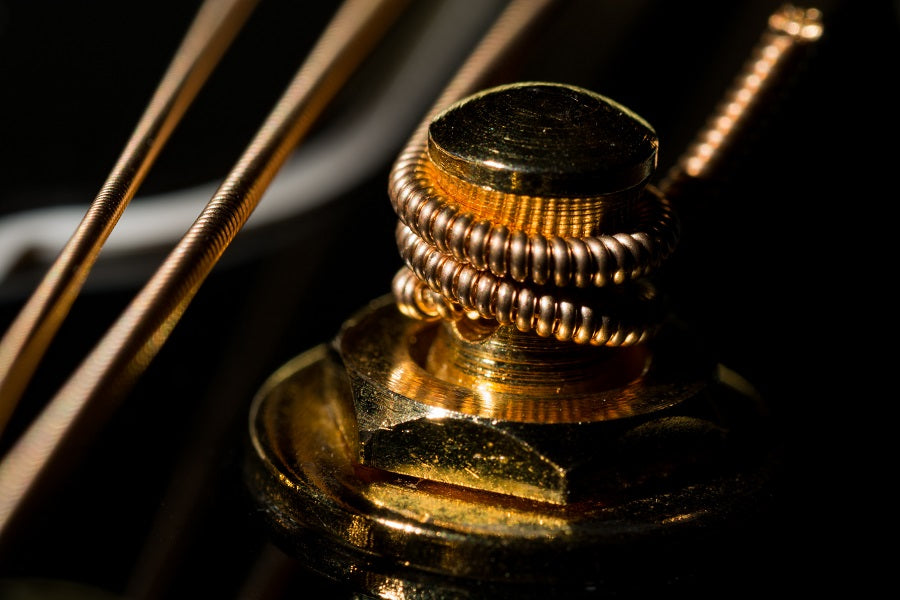
You will notice, the thickest guitar strings have a spiral wire wrapped-around, acting like a sanding file on the plectrum.
Guitar Pick Durability: How Long Should a Guitar Pick Last?
The short answer: If you are an average user, your picks should last a few weeks to a month. If you are a professional player, using specific techniques, like heavy picking and strumming, it will probably last just one day, especially if you are a studio musician recording new tracks every day.
The long answer: This answer includes many factors including guitar pick attributes, and external factors, regardless of the guitar pick you are using. We discuss all of them below.
Guitar Pick Attributes That Directly Affect the Durability
The attributes that define the durability of a guitar pick are as follows:
- Guitar Pick Material
- Guitar Pick Thickness
- Guitar Pick Tip Shape
- Guitar Pick Tip Texture
Harder materials will wear down slower. This is one of the reasons there has been a lot of research in the area of suitable materials for guitar picks.
The goal is to find a wear-resistant material, that keeps the tone characteristics that guitar players want, while still giving a good grip.
However, material is not all. The thickness of a guitar pick will enormously affect the wear and tear. Thinner picks will wear down almost immediately when using heavy pick techniques.

Other attributes of the pick that affect the durability, are the Tip Shape, and the Tip Texture. Very pointed guitar tips tend to wear down faster, because there is less material on the tip.
However, this problem can be partially solved with the right guitar pick tip texture. A polished tip on the guitar pick will cause less friction between strings and plectrum. This is one of the most underrated attributes of a guitar pick, and you can find more information HERE.
What Damages the Pick the Most?
Results show, that the best way of altering and degrading the shape of your plectrums is to perform “pick slides”.
This guitar technique will wear away the edges of your plectrum and will make it useless very quickly.
This won’t directly affect the tone or control of the plectrum, but the damaged sides will contain some dents. The plectrum will get stuck either on the up stroke or the down stroke.
External Factors Which Indirectly Affect the Durability
It’s not only the guitar pick quality that is responsible for its‘ damage. There are three more factors that can play a role on the durability:
- Hours of guitar training
- Guitar strings gauge
- Guitar playing style and used techniques
It is a very simple equation: The more hours you practice, the more your picks will get damaged.
Thicker guitar strings will increase the area of contact with your plectrum, and therefore, wear it down much faster.
Aggressive guitar playing techniques, like fast palm mute, or pick slides, will damage your guitar pick very easily.

How to know if a Pick is Durable?
The best way to find out, is to test it, and make your own judgment.
You can take advice of expert players, who have tested lots of guitar picks. However, if their playing styles differ from yours, this information won’t help much.
Besides, many expert players have not changed their picks for decades, and they might be missing the material improvements of the last decade.
As mentioned, not only is durability a factor to take into account when choosing a guitar pick, but also the tone and the ergonomics (grip, size,...).
How to Know When to Replace Your Pick?
If the edges of your pick are becoming more rounded, you might start to consider purchasing a new one.
However, never throw away your worn-down guitar picks! The rounded edges can be used to create more mellow tones, and you might want these for some of your songs.
One of the most important things about playing the guitar, is to keep your mind open to new tones and styles. This is the reason some guitar picks have rounded tips even when they are new.

In addition, you can store your old guitar picks in a box. I wish I still had my first guitar pick, that I used, when I was learned to play guitar as a child. A guitar pick can be a beautiful piece of your past.
Check Your Pick Condition Regularly
A tip from my side, is to double check every guitar pick before going out on stage, or studio. A visual inspection is fine.
Always keep some unused plectrums aside. Considering plectrums are probably the least expensive gear of your complete guitar rig, constant wear and tear issues is not a thing you should worry about.

Choose your ideal Plectrum
Are you using the right pick? This is a question you should ask yourself every time you play a song.
Some players have their 5-favourites, depending on the style and type of guitar they want to play.
The most important factors when choosing the right plectrum for you hinges on….
- Material
- Shape
- Thickness
- Size
- Playing style
- Your personal preference
We created a guide that will help you find the right plectrum for you.
You can find it HERE.
Thank you!
The support we are getting from the guitar community makes us very happy!
We, (Carlos and Judith), are really doing our best to create the best guitar picks for you.
If you consider supporting a small family start-up, you can share this article and directly have an influence on our online visibility.
These small actions have helped us since January 2019, and we count on your support! :)

Thanks!

6 Underrated Features Of A Guitar pick
In our article “How to choose the right guitar pick”, I summarized the aspects you should care about and consider when deciding which plectrum to use.
In this article, we will discuss the characteristics of a guitar pick we must pay attention to in order to make the playing experience much more comfortable and obtain better results. These aspects are not as obvious as others but are essential to get the most out of this incredible musical instrument.

1- Guitar Picks with Micronodules Grip Structure:
Grippy, non-sticky surfaces are perfect for the hold area on a guitar pick. The best way to achieve this is to create a texture, that fits between the grooves of your skin and prevents the guitar pick from slipping or creating an aggressive grip geometry that hurts the fingers of the guitarist.

2- High Mirror Polished Tip:
A guitar pick with a polished tip allows you to experience better control and less friction. In this way, reduced friction between the plectrum and the strings of the guitar will help increase the durability of the pick because it will wear less and reduce its noise.

3- Variable Thickness:
One of the less common characteristics in guitar picks is variable thickness. It is ideal for the guitar pick to be thick for better control; however, this could significantly reduce its flexibility.
For that reason, plectrums of variable thickness have been created, since this would give us the best of both aspects.
That is to say, we could have a guitar pick with a solid, thick body that gives us better grip. Additionally, it features a thinner tip that provides enough flexibility to achieve greater versatility when developing different guitar techniques.

Read more about the advantages of using a guitar pick with variable thickness in our article "5 advantages of a guitar pick with variable thickness"
4- Ergonomic Design Surfaces:
By following ergonomic models, the surface of the pick can be adapted to be comfortable, provide well-being and does not hurt the guitarist's fingers. It is advisable to look for picks with a 3D surface (those that are not flat) that have geometric patterns that offer a pleasant feeling to the grip. Similarly, we can take advantage of concave or convex surfaces, as they help keep the position of the plectrum oriented and avoid losing control in turning movements.
5- High-quality materials:
If your hands do an arduous job, then you must give them the right tools, right? Many people spend a lot of money on fancy guitars, cables, amplifiers, and other accessories but set aside the pick. This is a big mistake.
The material with which it is made can influence the definition of tone, attack, and flexibility. Therefore, without paying attention to it, you could hardly find your personal sound.
Are you curious about the materials used for the Rombo guitar picks?
Read a full article about it here:
https://rombopicks.com/blogs/insight-rombo/guitar-pick-materials-at-rombo
6- Unique Designs:
If you want to project an image with your own style, you must pay close attention to the design of your implements. To do this, you can try all the shapes and colors of guitar picks available in the market. Just imagine having one with an incredible appearance that is also very functional.

Conclusion:
In short, all aspects are subjective and depend on each person. Nevertheless, knowing such valuable information can expand our possibilities and options to choose the guitar pick that best suits our needs.
Tell us if you think this data can help you during the learning process of playing guitar and let us know if there are any other details about guitar picks that you think we should consider.
PS: Remember, you should share your skills with the world. In the article, “MUSIC AND DIY GENERATION”, I explain how the Internet community of guitarists helped me understand the importance of sharing my work.
- Shop
- Dealers
- Legal Notice
- Terms of Service
- Refund Policy
- Shipping
- Privacy Policy
- Contact us
- Press
- FAQ
Sign up to get the latest on sales, new releases and more…
By signing up you agree to our privacy policy.
© 2025 ROMBO.
registered brand
Powered by Shopify


